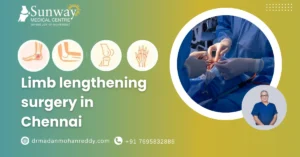After undergoing knee arthroscopy, recovery is a gradual process that depends on the extent of the repair and how well the body responds to treatment. For many, returning to normal movement and comfort takes patience and proper care. The knee arthroscopy recovery time usually involves a few weeks of rest, gentle exercises, and physiotherapy to rebuild strength. With consistent effort and following medical advice, most people regain flexibility and return to their daily routines smoothly.
What is Arthroscopic Knee Surgery?
Arthroscopic knee surgery is a minimally invasive procedure used to diagnose and treat various knee problems such as ligament tears, cartilage damage, or meniscus injuries. During the surgery, a small camera called an arthroscope is inserted through tiny incisions, allowing the surgeon to view and repair the joint with precision. This approach causes less tissue damage compared to traditional surgery, leading to quicker healing and less discomfort. The knee arthroscopy recovery time typically depends on the extent of the repair and the patient’s overall health, but most people can resume light activities within a few weeks. With proper rehabilitation and care, patients often regain full strength and mobility, enjoying a pain-free and active lifestyle once again.
How Long Does it Take to Recover from Arthroscopic Surgery?
Recovering from arthroscopic knee surgery is usually quicker and smoother than traditional open procedures, but the exact knee arthroscopy recovery time varies for each individual. Factors such as the type of repair, age, overall health, and commitment to rehabilitation play a major role in how fast recovery happens.
- Early Recovery Phase: In the initial days after surgery, rest, ice, and elevation help manage swelling and pain. Walking with support is usually possible, but avoid putting full weight on the knee. Gentle physiotherapy exercises are vital during this stage of knee arthroscopy recovery to maintain flexibility and prevent stiffness.
- Gradual Return to Activities: After a few weeks, movement and comfort improve noticeably. Physiotherapy strengthens the knee and restores balance, allowing light activities like walking or cycling. Full recovery and return to sports may take a few months, depending on the procedure’s complexity.

Advice for Faster Arthroscopic Knee Surgery Recovery
Recovering from knee surgery requires patience, care, and consistency. While each person heals differently, following the right steps can significantly improve your knee arthroscopy recovery time and help you regain strength more efficiently.
Follow Your Doctor’s Instructions
- Always adhere to your surgeon’s post-operative care plan.
- Take prescribed medications on time and attend follow-up appointments.
- Avoid self-diagnosing or resuming activities too soon, as this can delay healing.
Manage Swelling and Pain Effectively
- Apply ice packs several times a day to reduce inflammation.
- Keep your leg elevated when resting to minimize swelling.
- Gentle compression using a knee brace or wrap can also support the joint.
Focus on Physiotherapy and Gentle Exercises
- Start light stretching and strengthening exercises as recommended.
- Gradually increase intensity under your physiotherapist’s guidance.
- Consistency is key to a smooth recovery after knee arthroscopy and long-term mobility.
Maintain a Balanced Diet and Stay Hydrated
- Include protein-rich foods, fruits, and vegetables to support tissue repair.
- Drink plenty of water to improve circulation and aid faster recovery.
Prioritize Rest and Patience
- Healing takes time, so avoid pushing yourself too soon to prevent setbacks.
- Give your body enough rest to rebuild strength and support healing.
- Stay consistent with physiotherapy and follow your doctor’s advice.
- Be patient—progress happens gradually, week by week.
Restrictions After Knee Arthroscopy
Proper care and awareness of post-surgery restrictions play a crucial role in healing smoothly after a knee arthroscopy. While the procedure is minimally invasive, being mindful of your movements and daily habits can help shorten your knee arthroscopy recovery time and prevent complications.
Limit Weight-Bearing Activities
- Avoid putting full weight on your operated leg during the initial days.
- Use crutches or a walker as recommended by your doctor to support mobility.
- Gradually increase walking only when your knee feels stable and pain-free.
Avoid Strenuous Exercise or Twisting Movements
- Stay away from high-impact activities such as running, squatting, or jumping.
- Twisting or bending the knee excessively can strain healing tissues.
- Focus instead on gentle stretches and guided physiotherapy sessions to aid safe recovery.
Care for Your Incision Site
- Keep the surgical area clean and dry to avoid infection.
- Do not soak your leg in water (like in a bathtub or pool) until the stitches are fully healed.
- If you notice redness, swelling, or unusual discharge, contact your surgeon immediately.
Give Yourself Time to Heal
The recovery time for arthroscopy of the knee depends on the type of repair and your overall health. Rushing back into heavy activity too soon can delay healing. Be patient and consistent with rest, medication, and rehabilitation exercises — they all contribute to a faster and more complete recovery.
How Long Will My Knee Hurt After Arthroscopic Surgery?
Pain after arthroscopic knee surgery is common, but it usually lessens as healing progresses. The level and duration of discomfort depend on the type of repair, your overall health, and how well you follow post-surgery care guidelines. In most cases, mild soreness or stiffness may last for a few weeks as your body adjusts and heals.
- Understanding the Healing Process
During the early stage of knee arthroscopy recovery, it’s normal to feel some swelling and tenderness around the incision site. Applying ice packs, keeping the leg elevated, and taking prescribed pain medications can help manage discomfort effectively.
- When the Pain Starts to Ease
By following your physiotherapist’s exercises and avoiding excessive strain, you’ll notice gradual improvement. Light walking and stretching usually become easier within a few weeks. The knee arthroscopy recovery time for most people ranges between 4 to 6 weeks, though complete comfort may take longer if extensive repairs were done.
Tips to Reduce Pain Faster
- Stick to your rehab plan and perform exercises regularly.
- Avoid overexertion or high-impact movements until cleared by your doctor.
- Maintain a healthy diet to promote tissue healing and joint strength.
With consistent care and patience, your knee pain will steadily decrease, allowing you to regain flexibility and confidence in your movement.
Factors That Affect Recovery Time
Recovering after knee arthroscopy varies for every individual. While the procedure is minimally invasive, several factors influence how quickly you regain comfort and mobility. Understanding these aspects helps you take better care during the recovery time for arthroscopy of the knee and achieve smoother healing results.
1. Type of Surgery Performed
- The complexity of your procedure plays a major role in recovery.
- Simple diagnostic arthroscopy heals faster than repairs involving ligaments or cartilage.
- Larger repairs may require longer rest and physiotherapy to restore full function.
2. Physical Health and Fitness Level
- People who are active and maintain good muscle strength often recover more quickly.
- Underlying conditions like diabetes or obesity can slow down the healing process.
- Regular light exercise before and after surgery can improve blood flow and reduce stiffness.
3. Nutrition and Lifestyle Choices
- A balanced diet rich in proteins, vitamins, and antioxidants helps rebuild tissues.
- Staying hydrated supports joint lubrication and overall recovery.
- Avoiding smoking and alcohol speeds up the body’s natural healing ability.
4. Post-Surgery Care and Rehabilitation
- Following your doctor’s instructions and attending physiotherapy sessions are crucial.
- Overexertion or skipping exercises can delay progress.
- Consistency and patience during rehabilitation ensure a stronger and more flexible knee.
By paying attention to these factors, you can enhance your recovery journey and experience a smoother return to your daily activities after arthroscopy.
What are the Do’s and Don’ts After Knee Arthroscopy?
Following proper care after surgery helps you heal faster and reduce discomfort during your knee arthroscopy recovery time. Here’s a quick guide to keep your recovery smooth and safe.
Do’s
- Follow your doctor’s advice and take medicines on time.
- Apply ice and keep your leg elevated to reduce swelling.
- Start gentle exercises as recommended for better knee arthroscopy recovery.
- Keep the incision clean and dry.
- Eat healthy foods to support healing.
Don’ts
- Don’t lift heavy objects or twist your knee.
- Avoid skipping physiotherapy sessions.
- Don’t soak your leg in water until it’s healed.
- Avoid rushing back to full activity too soon.
By following these simple do’s and don’ts, you’ll recover faster and regain knee strength safely.
Conclusion
The knee arthroscopy recovery time depends on the type of procedure and how well you follow post-surgery care. With proper rest, exercises, and guidance, most patients recover smoothly. Always listen to your doctor and stay consistent with rehabilitation. For expert care, consult Dr. Madan mohan Reddy, the best orthopedic and knee surgeon in Chennai. His expertise ensures faster healing and long-lasting results.
Read More: Knee Ligament surgery




